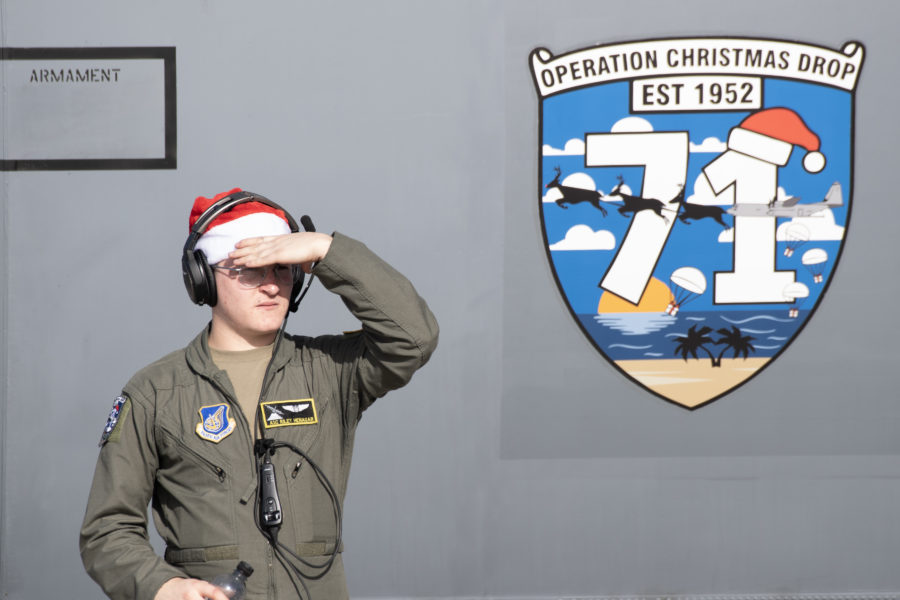The Air Force will begin its 71st annual Operation Christmas Drop on Dec. 4. The weeklong exercise is a yearly tradition that delivers supplies such as food, fishing equipment, school books, and clothes to remote islands in the Pacific. It is the longest-running Department of Defense humanitarian mission.
The U.S.-led effort is based out of Andersen Air Force Base in Guam. Aircrews plan to airdrop supplies to 56 remote islands in the Federated States of Micronesia and the Republic of Palau, Pacific Air Forces said.
“The tradition began during the Christmas season in 1952 when a B-29 Superfortress aircrew saw islanders waving at them from the island of Kapingamarangi, 3,500 miles southwest of Hawaii,” according to Andersen Air Force Base. “In the spirit of Christmas the aircrew dropped a bundle of supplies attached to a parachute to the islanders below, giving the operation its name.”
C-130s and Airmen from the 374th Airlift Wing at Yokota Air Base, Japan; the 36th Wing at Andersen Air Force Base, Guam, and the 15th Wing at Joint Base Pearl Harbor-Hickam, Hawaii, will join partners from the Japanese Air Self-Defense Force, Royal Australian Air Force, Royal New Zealand Air Force, Republic of Korea Air Force, and Indian Air Force, according to the U.S. Air Force.
For Operation Christmas drop, volunteers in Guam create drop-off boxes for books and raise money for the program from local businesses and citizens, and recieve some donations from people around world, according to the private foundation that coordinates the effort. Under the Denton Humanitarian Assistance Program, goods donated from nongovernmental sources can be transported—or airdropped—from U.S. military aircraft free of charge.
“These islands are some of the most remote locations on the globe spanning a distance nearly as broad as the continental U.S.,” according to Andersen Air Force Base. Aircrews are “linked to the village via ham radio as they fly overhead and drop supplies. The event provides readiness training to participating aircrew, allowing them to gain experience in conducting airdrops while providing critical supplies to 56 Micronesian islands impacting about 20,000 people; ultimately it’s a profound win for everyone involved.”
Crews conduct what are known as low-cost, low-altitude airdrops, according to Pacific Air Forces (PACAF). Low-cost, low-altitude (LCLA) airdrops contain bundles of cargo weighing up to 500 pounds and are dropped via parachute, according to the Air Force. The service has called it a “more accurate and flexible” way of providing supplies through larger airdropped container delivery systems (CDS) or landing to deliver supplies.
“Through the cooperation of local and military communities in the Asia-Pacific region, Operation Christmas Drop has delivered over 850,000 pounds of much needed food, supplies, tools, and toys to thousands of residents throughout Micronesia,” according to the Operation Christmas Drop foundation.
The mission also has a practical purpose, training crews to resupply areas in the Indo-Pacific. The Air Force has shifted more of its focus to the region in line with the National Defense Strategy, which sees China as America’s “pacing” challenge.
“The aerial delivery enables aircrews to develop and maintain combat readiness through aircraft generation and recovery across a remote region of the Pacific Ocean,” PACAF said in a news release.
But the mission is above all a humanitarian effort for the people who live on those isolated islands. According to Andersen Air Force Base, almost everything from coffee to cement can be donated. The story even made it to the silver screen as a romantic comedy in 2020. The film received mixed reviews.
The Air Force hopes the 2022 mission will fair better than the movie.
“Operation Christmas Drop continues to be an annual collaboration delivering valuable humanitarian assistance to those in need,” Col. Andrew Roddan, 374th Airlift Wing commander, said in a statement. “This operation helps to hone critical skills necessary for successful response to humanitarian assistance and disaster relief, and we look forward to continuing our successful joint efforts in support of humanitarian aid delivery.”
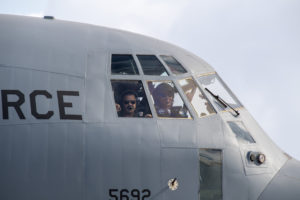
Crew members with the 36th Expeditionary Airlift Squadron wave from a C-130J Super Hercules after landing at Andersen Air Force Base, Guam, Nov. 30, 2022, during Operation Christmas Drop 2022. Operation Christmas Drop 2022. OCD is the longest-running Department of Defense humanitarian and disaster relief mission. (U.S. Air Force photo by Yasuo Osakabe)
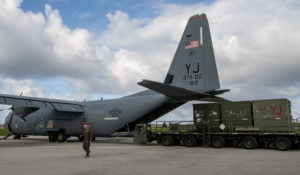
A crew member with the 36th Expeditionary Airlift Squadron walks down the flightline after offloading containers from a C-130J Super Hercules assigned to the 36th EAS at Andersen Air Force Base, Guam, Nov. 30, 2022, during Operation Christmas Drop 2022. The 36th EAS, subordinate to the Expeditionary Operations Group, activated as of Nov. 16, 2022 and is tasked to execute airdrop operations in support of OCD 2022. (U.S. Air Force photo by Yasuo Osakabe)
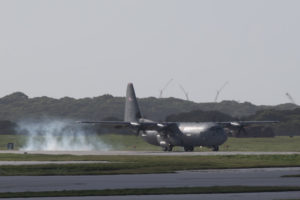
A U.S. Air Force C-130J Super Hercules assigned to the 36th Expeditionary Airlift Squadron touches down at Andersen Air Force Base, Guam, Nov. 30, 2022, during Operation Christmas Drop 2022. Three Yokota’s C-130Js carried with Airmen who participated in OCD arrived at same day. OCD is one of many events where U.S. and partner nation forces operate side by side, with this event emblematic of our mutual respect and cooperation with our friends and neighbors. (U.S. Air Force photo by Yasuo Osakabe)
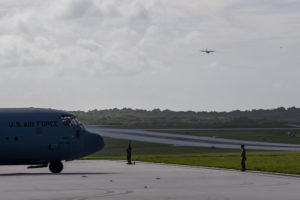
A U.S. Air Force C-130J Super Hercules assigned to the 36th Expeditionary Airlift Squadron approaches Andersen Air Force Base, Guam, Nov. 30, 2022, during Operation Christmas Drop 2022. Three Yokota C-130Js arrived with aircrew and support personnel to participate in OCD 2022. OCD 2022 is one of many events where U.S. and partner nation forces operate side by side, with this event emblematic of our mutual respect and cooperation with our friends and neighbors. (U.S. Air Force photo by Yasuo Osakabe)
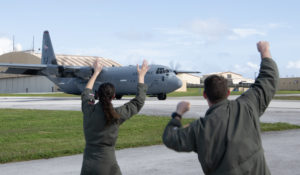
(Left to right) U.S. Air Force Capt. Jenn Brenton, and Capt. Andrew Zaldivar, 36th Expeditionary Airlift Squadron, greet Yokota’s C-130J Super Hercules at Andersen Air Force Base, Guam, Nov. 30, 2022, during Operation Christmas Drop 2022. Three Yokota’s C-130Js carried with Airmen who participated in OCD arrived at same day. OCD is one of many events where U.S. and partner nation forces operate side by side, with this event emblematic of our mutual respect and cooperation with our friends and neighbors. (U.S. Air Force photo by Yasuo Osakabe)
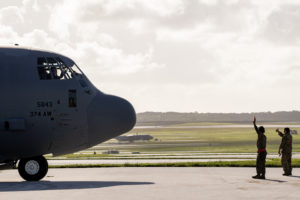
U.S. Air Force crewchiefs with the 374th Aircraft Maintenance Squadron marshal a C-130J Super Hercules assigned to the 36th Expeditionary Airlift Squadron at Andersen Air Force Base, Guam, Nov. 30, 2022, during Operation Christmas Drop 2022. Three Yokota’s C-130Js carried with Airmen who participated in OCD arrived at same day. OCD is one of many events where U.S. and partner nation forces operate side by side, with this event emblematic of our mutual respect and cooperation with our friends and neighbors. (U.S. Air Force photo by Yasuo Osakabe)
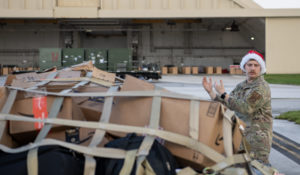
An Airman with the 36th Expeditionary Airlift Squadron, marshals a forklift at Andersen Air Force Base, Guam, Nov. 30, 2022, during Operation Christmas Drop 2022. Three Yokota’s C-130Js carried with Airmen who participated in OCD arrived at same day. OCD is one of many events where U.S. and partner nation forces operate side by side, with this event emblematic of our mutual respect and cooperation with our friends and neighbors. (U.S. Air Force photo by Yasuo Osakabe)
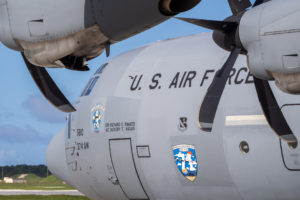
An U.S. Air Force C-130J Super Hercules assigned to the 36th Expeditionary Airlift Squadron sits on the flightline at Andersen Air Force Base, Guam, Nov. 30, 2022, during Operation Christmas Drop 2022. Three Yokota’s C-130Js carried with Airmen who participated in OCD arrived at same day. OCD is one of many events where U.S. and partner nation forces operate side by side, with this event emblematic of our mutual respect and cooperation with our friends and neighbors. (U.S. Air Force photo by Yasuo Osakabe)
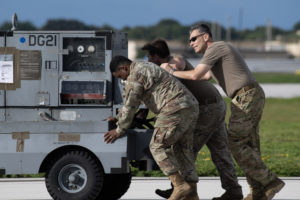
Members with the 374th Airlift Wing push a power generator at Andersen Air Force Base, Guam, Nov. 30, 2022, during Operation Christmas Drop 2022. Three Yokota’s C-130Js carried with Airmen who participated in OCD arrived at same day. OCD is one of many events where U.S. and partner nation forces operate side by side, with this event emblematic of our mutual respect and cooperation with our friends and neighbors. (U.S. Air Force photo by Yasuo Osakabe)
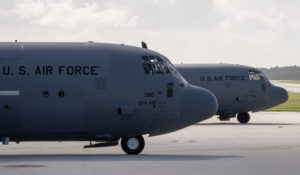
Two U.S. Air Force C-130J Super Hercules assigned to the 36th Expeditionary Airlift Squadron park on the flightline at Andersen Air Force Base, Guam, Nov. 30 ,2022. Three Yokota’s C-130Js carried with Airmen who participated in OCD arrived at same day. OCD is one of many events where U.S. and partner nation forces operate side by side, with this event emblematic of our mutual respect and cooperation with our friends and neighbors. (U.S. Air Force photo by Yasuo Osakabe)
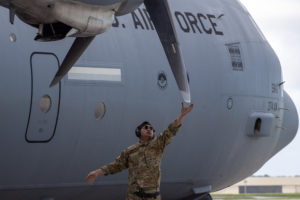
U.S. Air Force Staff Sgt. Bobby Khamphoumy, 374th Aircraft Maintenance Squadron dedicated crew chief, inspects the propeller blade of a C-130J Super Hercules aircraft to make sure there are no cracks or other damage Nov. 30, 2022, at Andersen Air Force Base, Guam, during Operation Christmas Drop 2022. Crew chiefs are responsible for performing numerous checks, tests and maintenance on aircraft to make sure the Air Force fleet is fit for flight. (U.S. Air Force photo by Yasuo Osakabe)
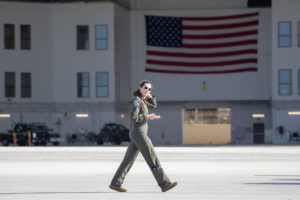
U.S. Air Force Capt. Jenn Brenton, 36th Expeditionary Airlift Squadron, deputy mission commander, walks at the flightline at Andersen Air Force Base, Guam, Nov. 30, 2022, during Operation Christmas Drop, 2022. OCD is the longest-running Department of Defense humanitarian and disaster relief mission. (U.S. Air Force photo by Yasuo Osakabe)
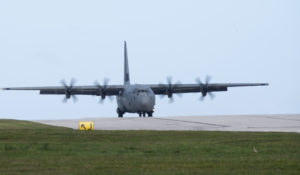
A U.S. Air Force C-130J Super Hercules assigned to the 36th Expeditionary Airlift Squadron taxis down the flightline at Andersen Air Force Base, Guam, Nov. 30, 2022, during Operation Christmas Drop 2022. OCD is the longest-running Department of Defense humanitarian and disaster relief mission. (U.S. Air Force photo by Yasuo Osakabe)
